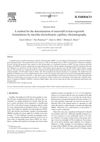TLDR Minoxidil detects nitrite in water, creating a simple, cheap test.
This paper presents a colorimetric experiment for detecting nitrite in water using minoxidil as a reagent. Minoxidil is a drug used to treat hair loss and produces a yellow product when reacted with nitrite in acidic media. The experiment is simple, inexpensive, and suitable for environmental, food, and physiological analytical applications. The authors suggest that the experiment can be used as a pedagogical tool to enhance students' curiosity, prediction capacity, and creativity.
 8 citations
,
January 2011 in “Organic and Biomolecular Chemistry”
8 citations
,
January 2011 in “Organic and Biomolecular Chemistry” Minoxidil reacts to nitrosation 7 times more than phenol, mainly due to its -NH₂ groups, leading to the creation of N-nitrosominoxidil.
 14 citations
,
September 2010 in “Annals of Plastic Surgery”
14 citations
,
September 2010 in “Annals of Plastic Surgery” Hair restoration has evolved from surgery to drugs to potential gene therapy, with improved results and ongoing research driven by high demand.
 23 citations
,
October 1988 in “Clinics in Dermatology”
23 citations
,
October 1988 in “Clinics in Dermatology” Minoxidil was first made for high blood pressure, but it was later found to help hair growth.
2 citations
,
April 1989 in “Archives of Dermatology” Minoxidil (Rogaine) effectively promotes hair growth in male pattern baldness.
April 1989 in “Archives of Dermatology” Minoxidil effectively treats male pattern baldness.
January 2023 in “Dermatologic Therapy” The new 5% minoxidil foam is as effective and safe as Rogaine® for treating hair loss in Chinese men.
 16 citations
,
January 1995 in “Skin Pharmacology and Physiology”
16 citations
,
January 1995 in “Skin Pharmacology and Physiology” SEPA™ enhances the effectiveness of minoxidil in stimulating hair growth, working faster and better than Rogaine® TS, with no significant side effects.
Minoxidil (Rogaine) increased interest in treating male pattern baldness.
 6 citations
,
July 2005 in “Farmaco”
6 citations
,
July 2005 in “Farmaco” A quick and simple method was created to identify minoxidil in hair-growth products using micellar electrokinetic capillary chromatography.





